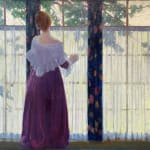

James Roy Hopkins American, 1877-1969
Hopkins was born in the small town of Irwin, Ohio and raised on a farm outside Mechanicsburg. In 1885-96, he studied electrical engineering at The Ohio State University before transferring to the Columbus Art School, now known as Columbus College of Art & Design. In 1904, he married Edna Boise Hopkins, an artist later known for her colored, modernist woodblock prints, and moved to Paris. While living in Paris, he painted elegant women and Impressionist nudes until the impending First World War forced a return to America in summer 1914.
Hopkins’ next position at the Cincinnati Art Academy would leading to him creating his notable works in the rural, Cumberland Falls, Kentucky area. In 1915, Hopkins was invited by Robert Stearns, lumber magnate, landowner, coal baron, and cultured industrialist, to visit southeastern Kentucky. Between 1915 and 1919, Hopkins created pioneering works depicting farmers, traveling preachers, children, courtship, and life in the mountains. In these Cumberland Suite works, he painted the Appalachian people in a penetrating and distinctive style that brought him national recognition. He was the first American painter to do so and prefigures Regionalism and American Scene painting that emerged some fifteen years later. Regionalism is painting that focuses on the customs, people, and topography of rural and small town America. American Scene encompasses both Regionalism and Social Realism, which features urban and politically motivated works.
From 1923–48, Hopkins is inextricably and enduringly linked to The Ohio State University. At OSU, he made the study, production, and teaching of art a lifelong commitment as the chair of the art department. Though his output as a painter fell off considerably, his tenure at Ohio State decisively shaped how the arts were taught there and raised its stature to national prominence. Hopkins Hall is named in his honor.
Join our mailing list
* denotes required fields
We will process the personal data you have supplied in accordance with our privacy policy (available on request). You can unsubscribe or change your preferences at any time by clicking the link in our emails.

